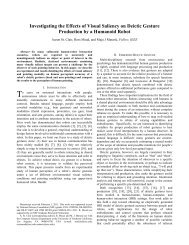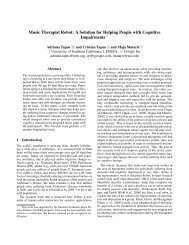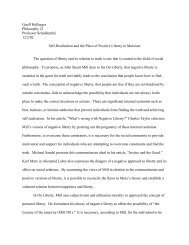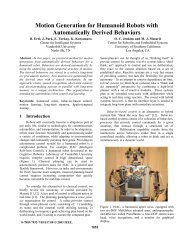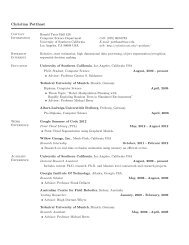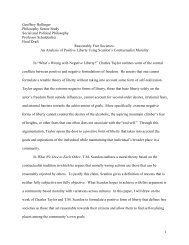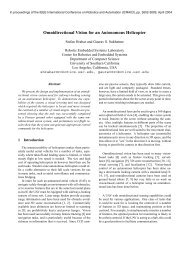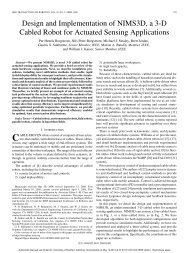A Socially Assistive Robot Exercise Coach for the Elderly
A Socially Assistive Robot Exercise Coach for the Elderly
A Socially Assistive Robot Exercise Coach for the Elderly
Create successful ePaper yourself
Turn your PDF publications into a flip-book with our unique Google optimized e-Paper software.
Fasola & Matarić. A SAR <strong>Exercise</strong> <strong>Coach</strong> <strong>for</strong> <strong>the</strong> <strong>Elderly</strong>segmented image. The motion frame, once thresholded, serves as <strong>the</strong> segmentation inputin <strong>the</strong> first step of <strong>the</strong> algorithm, and <strong>the</strong> user arm angles can be determined in <strong>the</strong> samemanner as described. Using motion instead of color segmentation, along with Kalmanfiltering of <strong>the</strong> positions of <strong>the</strong> hands and elbows, provides a more general recognitionapproach <strong>for</strong> domain-independent use, even though <strong>the</strong> overall algorithm remains <strong>the</strong>same.The development of <strong>the</strong> SAR exercise system and visual recognition procedurepredated <strong>the</strong> availability of <strong>the</strong> Microsoft Kinect. Our future implementations of <strong>the</strong>system will utilize Kinect-type 3D vision technology and thus do away with <strong>the</strong> curtainand <strong>the</strong> planar limits of <strong>the</strong> motions. Never<strong>the</strong>less, <strong>the</strong> 2D nature of <strong>the</strong> exercises was notnoted as an issue by any of <strong>the</strong> participants in our user studies. Fur<strong>the</strong>rmore, <strong>the</strong> real-timevision algorithm described is general and can be applied to a variety of domains,including those wherein use of <strong>the</strong> Kinect is not appropriate or feasible (e.g., outdoors insunlight).3.6 BehaviorsThe behavior module represents <strong>the</strong> main loop of <strong>the</strong> SAR exercise coach system. Itcommunicates with all of <strong>the</strong> o<strong>the</strong>r system modules and manages <strong>the</strong> flow of <strong>the</strong>interaction, including transitioning between <strong>the</strong> different exercise games, managing <strong>the</strong>session and game clocks, saving user per<strong>for</strong>mance and session statistics to <strong>the</strong> database,and handling user-requested breaks, among o<strong>the</strong>r session-related tasks.3.6.1 Interaction Flow and Behavior ManagementEach of <strong>the</strong> four exercise games is managed by its own game behavior. In accordancewith our principle of encouraging users to be intrinsically motivated to engage in <strong>the</strong> task,<strong>the</strong> behavior module transitions between game types every 1–2.5 minutes in order todiminish <strong>the</strong> possibility of user boredom, which would negatively affect motivation level.The behavior module chooses which game to transition to based on a predefined sessionschedule, which specifies <strong>the</strong> order of <strong>the</strong> games to play and <strong>the</strong>ir respective durations.The session schedule is defined a priori by <strong>the</strong> experimenter such that each session’sorder of games is unique. This requirement is en<strong>for</strong>ced to reduce <strong>the</strong> predictability of <strong>the</strong>exercise regimen <strong>for</strong> <strong>the</strong> user, which might negatively affect his or her perception of <strong>the</strong>system (Bickmore, Schulman, & Yin, 2010). The session schedule, however, thoughunique <strong>for</strong> each individual session, follows approximately <strong>the</strong> same structure throughoutall of <strong>the</strong> sessions. Specifically, <strong>the</strong> Workout, Sequence, and Memory games are eachallotted approximately 25% of <strong>the</strong> total session time (75% <strong>for</strong> all three games), with <strong>the</strong>Imitation game being allotted 15% of <strong>the</strong> total session time and <strong>the</strong> remaining 10% beingallocated <strong>for</strong> user breaks, transition behaviors, and <strong>the</strong> introduction and conclusion of <strong>the</strong>session. The Imitation game receives a lower allotment compared to <strong>the</strong> o<strong>the</strong>r threegames due to <strong>the</strong> fact that <strong>the</strong> user is in control of <strong>the</strong> exercise. Although <strong>the</strong> Imitationgame promotes user autonomy and users often find <strong>the</strong> game stimulating, in pilot studieswe’ve observed users may get bored if <strong>the</strong> game goes on <strong>for</strong> too long. Thus <strong>the</strong> Imitationgame is usually only played <strong>for</strong> 1–1.5 minutes at a time during <strong>the</strong> course of <strong>the</strong> exercisesession. If a session schedule is not set, or is incomplete, <strong>the</strong> robot chooses a game atrandom to play at regular game change intervals. The exact durations <strong>for</strong> each game weredetermined empirically by taking into account multiple factors, including <strong>the</strong> totalduration of <strong>the</strong> session (20 minutes), <strong>the</strong> allotted game time ratio, <strong>the</strong> time required <strong>for</strong>15



